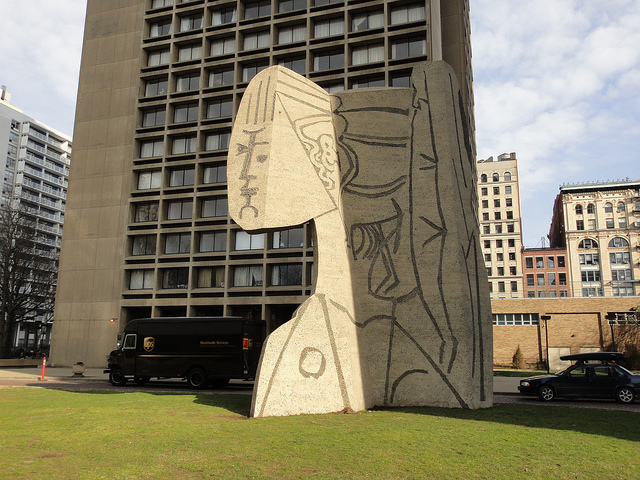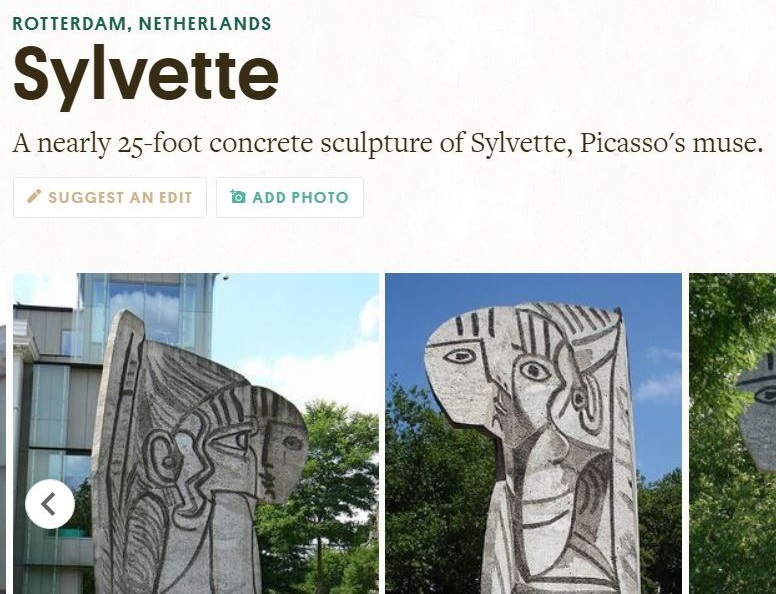Picasso’s “Bust of Sylvette” sculpture in New York City’s Greenwich Village. Image courtesy of Art Nerd New York
Picasso’s sculpture—also named “Sylvette” —in Rotterdam. Image courtesy of Wikipedia, photo by K. Siereveld
AS WE WERE SAYING…
In a previous post we spoke about what we believed to be Paul Rudolph’s project for a visitors & arts center for the University of South Florida’s Tampa-area campus. It was to include a monumental concrete statue by Picasso—which, had it been constructed, would have been enormous: over 100 feet tall. Here is the perspective drawing for the proposed building, which shows the sculpture as part of the overall composition:
Rendering of the proposed visitors and arts center for the University of South Florida in Tampa. Picasso’s sculpture, which was to sit on the adjacent plaza, would have been a massive presence. Image courtesy of the USF Special Collection Library
What prompted us to explore this project is that visitors to the Modulightor Building in New York are intrigued by a Picasso sculpture which is on display within the building: a copy of the original maquette for that monumental sculpture:
Picasso’s maquette for the sculpture that was to go on the plaza of the University of South Florida. This authorized copy of the maquette is in the Modulightor Building in New York. Image © The Estate of Paul Rudolph, The Paul Rudolph Heritage Foundation.
That’s an authorized copy: Paul Rudolph obtained permission from Picasso to make it, because Rudolph admired Picasso’s sculpture so much.
In our earlier post, we’d given an art-biographical context these sculptures, noting other examples of Picasso’s work at monumental public scale. The prime example cited is his large work in New York City’s Greenwich Village: the concrete “Bust of Sylvette”:
Picasso’s Sylvette, in the midst of the I.M. Pei’s “Silver Towers” in NYC’s Greenwich Village. Image courtesy of Ephemeral New York
STILL, THEY’RE COUSINS…
Well, we’ve just heard about another sculpture by Picasso that we thought you’d like to know about—and this one has a similar title: “Sylvette”. It is located in Rotterdam, The Netherlands, and is in the city’s center, on a site on the Westersingel canal.
That ever-fascinating website, Atlas Obscura, has done a story about it (which drew our attention to the Rotterdam “Sylvette”), and it includes several photos showing the sculpture in its urban setting:
A screen grab from Atlas Obscura’s web page,showing the Picasso “Sylvette” in Rotterdam.
At the Sculpture International Rotterdam website, there are several pages on the sculpture, including a full essay, and also information on the various sites it has occupied in Rotterdam.
Is the Rotterdam sculpture a sister with the one in New York?
Cousins?
You decide!
















